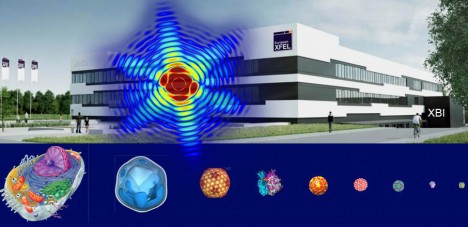The contracts have been signed at the end of June, from September on the bio lab XBI (Integrated Biology Infrastructure) at the European XFEL in Schenefeld will be equipped. An interdisciplinary team led by CUI scientist Prof. Christian Betzel (Universität Hamburg) has been awarded almost one million Euro from the Federal Ministry of Research and Education (BMBF) for a joint research project in the future bio lab. Funding for the project, “BioXFEL: Sample Preparation and Scoring at XFEL and XBI: From Living Cells to Nanocrystals”, will be provided over a period of four years until 2019 within the framework of the German-Swedish cooperation (Röntgen-Ångström-Cluster) on “Materials Research and Structural Biology using Neutron and Synchrotron Radiation”.

In the bio lab XBI, the scientists will work on highly relevant research projects from complementary areas of the life sciences. ©Betzel/Hajdu
The project between Universität Hamburg, University Hospital Hamburg (UKE), the Biozentrum Klein Flottbek, the Center for Free-Electron Laser Science (CFEL) and the University of Uppsala brings together world-leading scientists in the biological exploitation of free-electron lasers. German partners include CUI scientists Prof. Martin Aepfelbacher (UKE), Prof. Henry Chapman, Prof. Franz X. Kärtner (both Universität Hamburg, DESY, CFEL) and Prof. Henning Tidow (Universität Hamburg) plus Prof. Wilhelm Schäfer of Biozentrum Klein Flottbek (Universität Hamburg). The Swedish research is coordinated by Prof. Janos Hajdu (University Uppsala).
The complementary expertise of the participating groups will be used to establish an innovative instrumentation and infrastructure in the new biology lab. “Such an infrastructure is an essential element of the whole sample cycle from producing, preparing, characterizing and sorting up to optimizing biomolecular samples and suspensions for biological structural analysis at the European XFEL,” says project coordinator Christian Betzel. In particular the scientists want to install and combine innovative methods such as Second Harmonic Generation (SHG), Dynamic Light Scattering (DLS) and modern sorting methods. In parallel the teams will work on highly relevant research projects from complementary areas of the life sciences – from living cells to nanocrystals. They will deliver target proteins and bio particles to be analyzed at the European XFEL. At the same time these proteins and particles help to optimize and establish instrumentation. Betzel: “We will combine the latest techniques, and develop new procedures for researching macromolecules, viruses, cell organelles, cells and nanocrystals. This research at the frontiers of biophysics and photon science will offer unique insights into cell and infection biology.”

